|
|
|
Sort Order |
|
|
|
Items / Page
|
|
|
|
|
|
|
| Srl | Item |
| 1 |
ID:
168901


|
|
|
|
|
| Summary/Abstract |
This research presents a typology of terrorist events rather than the more common typologies of terrorist groups and ideologies. Archetypal analysis, a quantitative methodology to identify pure types, was used with data in START's Global Terrorism Database to identify archetypal attacks in the United States. A set of seven archetypal events was identified including abortion bombings, poisonings, Aryan hate, hostage-taking, fire/bomb for damage, assassination, and the catastrophic Big Bad. These archetypes may be useful for training and exercising for events with additional potential value for developing theory of terrorist events.
|
|
|
|
|
|
|
|
|
|
|
|
|
|
|
|
| 2 |
ID:
168896


|
|
|
|
|
| Summary/Abstract |
This article looks specifically at the front end of the radicalization problem and argues that vulnerability to political violence is first and foremost a social problem. The article explores the historical counterradicalization approach in Britain and the government/community relationship, and argues that addressing the disaffection that comes with social vulnerability is the key to building resilience to radicalization. Last, the article profiles a holistic counterradicalization response undertaken by Quintessential Insight and the Barking Mosque whereby social vulnerability is reduced, individuals and communities are empowered, social and political agency is maximized, social contracts are restored, and resilience to radicalization is increased.
|
|
|
|
|
|
|
|
|
|
|
|
|
|
|
|
| 3 |
ID:
168900
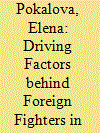

|
|
|
|
|
| Summary/Abstract |
With the rise of the self-proclaimed Islamic State of Iraq and Syria (ISIS), the phenomenon of foreign fighters became a significant security concern. Governments around the world have become preoccupied with the possibility of their citizens leaving for combat zones and then coming back with training and experience. While previously foreign fighters participated in such conflicts as Afghanistan, Bosnia, or Chechnya, today ISIS has attracted record numbers of individuals from various backgrounds. This article examines factors that might be connected with the outflow of foreign fighters to Syria and Iraq. The analysis is based on 190 countries with 103 of them serving as countries of origin for 33,815 foreign fighters. Negative binomial regression is used to evaluate the connection of political, economic, demographic, and social factors to numbers of foreign fighters. The findings indicate that more foreign fighters come from countries with higher Human Development Index levels, unemployment rates, percentages of youth, population size, percentages of Muslim population, emigration levels, Internet penetration, and the presence of Al Qaeda cells. However, the findings further indicate that the effect of these variables is not uniform across majority Muslim and majority non-Muslim countries.
|
|
|
|
|
|
|
|
|
|
|
|
|
|
|
|
| 4 |
ID:
168898
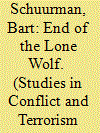

|
|
|
|
|
| Summary/Abstract |
This research note argues that the “lone wolf” typology should be fundamentally reconsidered. Based on a three-year empirical research project, two key points are made to support this argument. First, the authors found that ties to online and offline radical milieus are critical to lone actors' adoption and maintenance of both the motive and capability to commit acts of terrorism. Second, in terms of pre-attack behaviors, the majority of lone actors are not the stealthy and highly capable terrorists the “lone wolf” moniker alludes to. These findings not only urge a reconsideration of the utility of the lone-wolf concept, they are also particularly relevant for counterterrorism professionals, whose conceptions of this threat may have closed off avenues for detection and interdiction that do, in fact, exist.
|
|
|
|
|
|
|
|
|
|
|
|
|
|
|
|
| 5 |
ID:
168902
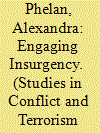

|
|
|
|
|
| Summary/Abstract |
The 2016 Peace Agreement between the Colombian government and the Revolutionary Armed Forces of Colombia—People's Army (the FARC-EP or FARC) commits to reforming political participation, especially of traditionally marginalized sectors throughout the country to consolidate Colombian democracy. While the Peace Agreement provides implementation mechanisms that support the insurgency's transition from armed group to political party, it also complements the FARC's political strategy that has traditionally maintained consistency. This article argues that the 2016 Peace Agreement has the potential to enhance democratic, political, and societal participation by engaging with FARC in two key ways—by attempting to reconcile key FARC grievances and containing specific mechanisms that increase participation of traditionally marginalized groups in Colombia. This article argues that the Agreement has impacted positively on FARC's political participation and given it incentives to pursue its political strategy democratically. Likewise, the Agreement has provided a positive-sum outcome for the Colombian government to strengthen its democratic legitimacy by placing emphasis on structural reform.
|
|
|
|
|
|
|
|
|
|
|
|
|
|
|
|
| 6 |
ID:
168894


|
|
|
|
|
| Summary/Abstract |
This article examines Hamas as a test case for the struggle within Islam between two rival ideological streams: wasatiyya, whose principles were formulated by Sheikh Yusuf al-Qaradawi (b. 1926), and Salafi-jihadism, which is the wellspring of global jihad. Hamas is a wasati movement, and its wasati principles serve as the basis for its polemic with Salafi-jihadists, who accuse both it and al-Qaradawi of heresy. The article also shows how the principles of wasatiyya afford Hamas flexibility and allow it to adopt pragmatic positions by distinguishing between immutable long-term goals and flexible means of pursuing them. Hamas translates the principles of wasati jurisprudence into practical political and military ones.
|
|
|
|
|
|
|
|
|
|
|
|
|
|
|
|
| 7 |
ID:
168891
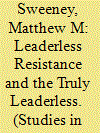

|
|
|
|
|
| Summary/Abstract |
The literature on leaderless resistance is conceptually cloudy. Nevertheless, such literature has bounded the theoretical framework of leaderless resistance around four criteria. These criteria are leaderless resistors cannot be members of organizations they represent; leaderless resistance is a tactical manifestation of an organization; the goal of leaderless resistance is to insulate members and leaders from prosecution; and leaderless resistance arises from organizational failure. Using a case study of the Phineas Priesthood, this work tests these boundaries via a directed content analysis of the Priesthood's ideological manifesto. This research finds that leaderless resistance is theoretically problematic and too often lone wolves and leader resistors are viewed equivalent when they are theoretically different. Scholars must theoretically differentiate between individuals who ascribe to leaderless concepts, organizations, or groups versus those who develop an ideological framework and exist outside a concept, organization, or group.
|
|
|
|
|
|
|
|
|
|
|
|
|
|
|
|
| 8 |
ID:
168897


|
|
|
|
|
| Summary/Abstract |
Countering violent extremism (CVE) is one of the central focuses of the government of Pakistan. This article examines the current CVE policy framework and questions the existing paradigm of CVE policies in Pakistan. The article employs R. Kim Cragin's model of “resisting violent extremism” to suggest the need for a paradigm change in Pakistan's CVE policy framework, especially after the launch of another military operation in 2017. After a decade of security-centric counterterrorism policies, such a change requires balancing security-, development-, and prevention-centric policies in order to redefine Pakistan's policy framework.
|
|
|
|
|
|
|
|
|
|
|
|
|
|
|
|
| 9 |
ID:
168893


|
|
|
|
|
| Summary/Abstract |
This article describes an empirical study into processes of homegrown radicalization and de-radicalization of young people. Researchers in Denmark and the Netherlands set out to answer the question regarding what pathways in and out of extremism (mainly far-right or Islamist) look like “from the inside.” The analysis is informed by grounded theory, based on interviews (N = 34) with “formers” and their family members on their life courses. The study shows that radicalization often concurs with distinct social–emotional developmental challenges that young people face in the transition between youth and adulthood. A practical implication of the marked transitional sequences in these processes is that each type of radical journey may call for a different type of (re)action.
|
|
|
|
|
|
|
|
|
|
|
|
|
|
|
|
| 10 |
ID:
168899


|
|
|
|
|
| Summary/Abstract |
This article argues that inaccurate translation of commonly-transliterated jihadist terms poses a major difficulty to scholars and policy makers who are seeking to understand the appeal and potential weaknesses of jihadist movements. Jihadist English-language propaganda is filled with transliterated terms, usually from Arabic. Although these transliterated terms (such as jihad and sharia) are extremely common, the shorthand English translations of these terms (such as “holy war” and “Islamic law”) often fail to accurately convey the connotative meaning experienced by the jihadist groups using them.
|
|
|
|
|
|
|
|
|
|
|
|
|
|
|
|
| 11 |
ID:
168892


|
|
|
|
|
| Summary/Abstract |
Since the violent escalation of the Syrian conflict, 280 Dutch nationals have been flocking to Syria and Iraq to join jihadist terrorist organizations. Attempts to create a more comprehensive understanding of the backgrounds of these jihadist foreign fighters often rely on small-N, qualitative analysis. This exploratory study systematically assesses the backgrounds of 217 Dutch jihadist foreign fighters. Additionally, it further differentiates the different “waves” of fighters since late 2012, by looking at their characteristics and comparing their composition.
|
|
|
|
|
|
|
|
|
|
|
|
|
|
|
|
| 12 |
ID:
168895
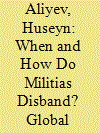

|
|
|
|
|
| Summary/Abstract |
The research to date on pro-governm`ent militias demonstrates that numerous pro-regime militia groups were actively deployed in civil wars over the last half a century. As hundreds of militia groups emerged amid civil warfare, hundreds more were disbanded, integrated into regular military, or transformed into political forces. This study seeks to improve our understanding of global patterns of militia demobilization. In contrast to the growing body of literature that explores the emergence of militias or examines their relationship with the state, studies on the demise of pro-government militias are notable by their absence. Statistical analysis of 220 pro-government militias involved in seventy-five civil wars from 1981 to 2011, based on a recent database of pro-government militias, demonstrates that the disappearance of militias has little to do with the termination of armed conflict. This study is the first to investigate when and under which conditions militias created to assist governments in fighting civil wars disband.
|
|
|
|
|
|
|
|
|
|
|
|
|
|
|
|
|
|
|
|
|